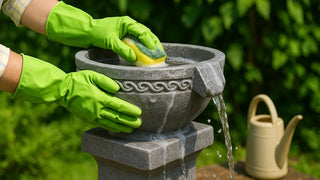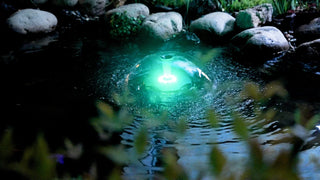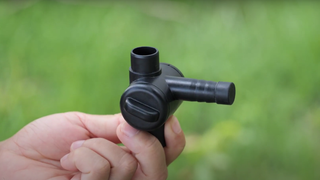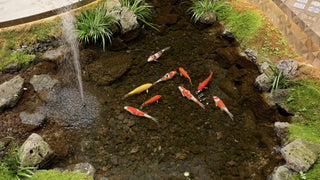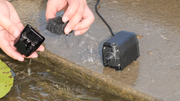
A pond pump is the hidden heart of every water garden. When it runs smoothly, you get crystal-clear water, steady oxygen for fish, and that gentle soundtrack of moving water that turns a backyard into an oasis. When it falters, everything spirals: algae blooms, odors build, fish gasp. Mastering pond pump maintenance isn’t complicated—but it does require a little knowledge, the right routine, and gear designed for real-world wear, like the solar and AC pumps Poposoap builds for year-round reliability. The guide below covers the weak points that shorten pump life, a step-by-step daily and seasonal care plan, quick fixes for common issues, and the design details that let Poposoap pumps outlast average backyard models.
Pond Pump Vulnerability Factors

Intake clogging: Leaves, fish waste, and string algae wrap around the impeller, forcing the motor to strain and overheat. In shallow wildlife ponds, tadpoles or snails can jam the rotor overnight.
Dry-running: Even a solar fountain will burn out if water levels drop below the intake for more than a few minutes. Summer evaporation, leaking liners, or playful dogs splashing water onto the patio can leave the volute empty.
Scale and bio-film: Hard-water minerals crust onto the impeller shaft. A sticky bio-film then forms, slowing RPMs and raising power draw. You’ll see the flow drop by half long before the pump finally stalls.
Voltage spikes & thermal stress: Direct-wired units can suffer when extension cords sit in wet grass. Solar pumps face the opposite challenge—voltage dips under cloud cover cause repeated start-stop cycles that wear on cheap electronics.
Seasonal debris loads: Spring pollen, autumn leaves, and winter ice shards all use the same path through the volute. Pumps that lack a decent pre-filter age in dog years.
Poposoap solution: Every pump in the lineup ships with a snap-on foam strainer or fits into a modular pre-filter box. Solar models incorporate a low-water shut-off sensor that pauses the motor before damage occurs.
Daily Maintenance Guide

Morning flow check: Stand where you can see the waterfall or fountain plume. A healthy pump produces the same arc every day. If the stream looks weak or breaks into dribbles, lift the pump basket and rinse the intake foam in a bucket of pond water—never under chlorinated tap water that would kill the nitrifying bio-film. This 30-second habit prevents 80% of emergency call-outs.
Skim surface debris: A hand net removes floating leaves before they sink and reach the pump. Less debris entering means fewer blockages later.
Top up evaporated water: Solar pumps, such as the Poposoap 20-watt fountain, rely on steady depth. Add dechlorinated water when the level drops 2 cm below the skimmer mouth to avoid dry-running.
Quick electrical glance: For AC units, make sure the outdoor-rated plug sits above the splash line and the GFCI hasn’t tripped. Solar users just check the panel angle and wipe dust from the glass.
Key to Seasonal Maintenance
Spring
- Deep-clean the impeller housing. Unplug the pump, twist off the volute, and slide out the ceramic shaft. A soft toothbrush plus white vinegar dissolves six months of lime scale without scratching the parts.
- Replace any sponge pre-filter that fails to spring back after squeezing. Compressing foam all winter shortens its life span.
- Inspect O-rings for cracks. Poposoap supplies spares in the original hardware bag; smear a dab of silicone grease before reinstalling.
Summer
- Shift the pump 5–10 cm deeper to compensate for higher evaporation.
- If an unexpected heat wave pushes water temps above 30 °C, swap the stock fountain head for a Poposoap foam-jet nozzle that moves a wider column of water and improves oxygen transfer.
- For solar systems, add an optional lithium battery pack so the pump coasts through late-afternoon clouds, avoiding repeated start-stop cycles.
Autumn
- Install a leaf net over the pond before the first big drop. Less debris equals happier pumps.
- Back-flush the waterfall hose to clear acorns and small twigs.
- Shorten daylight-run time on AC pumps if fish appetite drops—lower flow still turns the pond every two hours, saves electricity, and reduces wear.
Winter
- In zones that freeze, lift the pump to a mid-depth shelf so it sits above the coldest strata and below surface ice.
- Poposoap pond aerators keep an ice-free vent; that prevents freeze-pressure cracking the plumbing.
- If you choose to store the pump indoors, submerge it in a bucket of water to keep the seals wet. Dry rubber shrinks and cracks.
Quick Troubleshooting
Problem: Pump hums but no water moves
Likely a jammed impeller. Cut power, open the volute, and unwind string algae. If the rotor spins freely by hand, reassemble; flow should return instantly.
Problem: Flow surges in pulses
Air is entering the line. Check the intake to ensure the foam isn’t floating, and verify hose connections are tight. In solar units, ensure the panel isn’t shaded; low voltage can mimic air-lock symptoms.
Problem: Pump trips the breaker
Moisture may have infiltrated the plug or cord. Dry and inspect the cable for nicks. Poposoap AC pumps use double-seal housings, but a damaged cord can still short.
Problem: Vibration or rattling sound
An impeller magnet may be chipped. Poposoap supplies replacement rotors; swap in a new one and the pump should run silently.
Problem: Solar pump stops at noon clouds
Add the quick-connect Poposoap battery pack or tilt the panel to capture stronger morning and afternoon sun.
These pump tips solve 90% of breakdowns without calling a technician and let you extend pump life well past the typical three-year mark.
Poposoap Pump Design and Durability

Poposoap designs every pump—from the 6-watt bird-bath fountain to the 70-watt floating geyser—around three principles: energy efficiency, modular protection, and field-service parts. Rotor shafts are ceramic rather than metal, resisting wear in gritty ponds. The ABS pump body withstands UV for ten seasons without brittleness. Intake screens snap off without tools so you can clear a jam even in winter gloves.
Solar models include a dedicated low-water sensor that shuts the motor before cavitation. Paired with a Poposoap filter box, a pump handles debris loads normal hobby pumps would choke on. AC pond pumps use fully encapsulated windings and thermal cut-outs to survive accidental leaf lock. And because every impeller, O-ring, or foam sleeve is sold separately, a quick swap on the patio keeps the entire system running instead of sending it to landfill.
Conclusion: Keep the Heart Beating Strong
Regular pond pump maintenance is less chore than habit—five minutes a day, fifteen minutes a season, and an occasional vinegar bath. Follow the simple checklist above and you’ll protect the motor, lower your energy bill, and enjoy uninterrupted waterfalls all year. Combine those habits with Poposoap’s weather-sealed design, snap-on pre-filters, efficient impellers, and solar-powered options, and you’ll not only extend pump life but also free yourself to enjoy what the pump was meant to deliver: clear water, vibrant fish, and the calm sound of flow. In short, treat the pump like the pond’s heartbeat—keep it clean, keep it moving, and it will reward you with years of whisper-quiet service.





